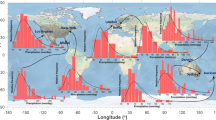Abstract
Regional climate classification aids the investigation of the causes of changes in natural vegetation distribution and allows the selection of appropriate crops under climate fluctuations. In this study, the Japanese climate was classified using a simple convolutional network (CNN) into nine regional areas based on meteorological factors (channels). One dataset of each channel was processed by an arrangement into two dimensions of 12 months and 10 years. Combinations of five channels were used by the CNN to search for the best combination for climate classification. A combination of four channels, excluding snow depth data, showed the best test accuracy. Regional climate change was analyzed by comparing the different patterns between the latest and former decades. The climate in most regions tended to shift towards the north. However, the number of regions that shifted towards north decreased in the most recent decade compared with those in previous decades, indicating that Japanese climate is generally oriented southward. The simple convolutional network based on the processed two-dimensional data from the meteorological time-series dataset enabled recent climate change evaluation and predicted regional climate change, which could help decision makers for choosing crops and formulating disaster management strategies in the near future.






Similar content being viewed by others
Data availability
The climatic data used in this study are available in the Japanese Meteorological Agency. http://www.data.jma.go.jp/obd/stats/etrn/index.php (Japanese version).
Code availability
Not applicable.
Abbreviations
- CNN:
-
Convolutional neural network
- DL:
-
Deep learning
- T:
-
Temperature
- P:
-
Precipitation
- W:
-
Wind speed
- Sun:
-
Sunshine duration
- Snow:
-
Snow depth
- P1:
-
1979–1988
- P2:
-
1989–1998
- P3:
-
1999–2008
- P4:
-
2009–2018
References
Chattopadhyay A, Hassanzadeh P, Pasha S (2020) Predicting clustered weather patterns: a test case for applications of convolutional neural networks to spatio-temporal climate data. Sci Rep 10:1317. https://doi.org/10.1038/s41598-020-57897-9
Huntingford C, Jeffers ES, Bonsall MB et al (2019) Machine learning and artificial intelligence to aid climate change research and preparedness. Environ Res Lett 14:124007. https://doi.org/10.1088/1748-9326/ab4e55
Ise T, Oba Y (2019) Forecasting climatic trends using neural networks: an experimental study using global historical data. Front Robot AI 6:32. https://doi.org/10.3389/frobt.2019.00032
Ise T, Oba Y (2020) VARENN: graphical representation of periodic data and application to climate studies. NPJ Clim Atmos Sci 3:26. https://doi.org/10.1038/s41612-020-0129-x
Ishizaka M (2004) Climatic response of snow depth to recent warmer winter seasons in heavy-snowfall areas in Japan. Ann Glaciol 38:299–304
Japanese Meteorological Agency (2019) Climate Change Monitoring Report 2018:1–92. https://www.jma.go.jp/jma/en/NMHS/ccmr/ccmr2018.pdf. Accessed 25 October 2021
Japanese Meteorological Agency. (2021a) https://www.jma.go.jp/jma/en/Activities/amedas/amedas.html. Accessed 25 Oct 2021
Japanese Meteorological Agency. (2021b) https://www.data.jma.go.jp/gmd/cpd/longfcst/en/tourist.html. Accessed 25 Oct 2021
Krizhevsky A, Sutskever I, Hinton GE (2012) NIPS'12 ImageNet classification with deep convolutional neural networks. Proceedings of the 25th international conference on neural information processing systems 1:1097–1105
Liu Y, Racah E, Prabjat et al. (2016) Application of deep convolutional neural networks for detecting extreme weather in climate datasets. arXiv Preprint arXiv:1605.01156. CS.cv. https://arxiv.org/abs/1605.01156
Matsui T, Takahashi K, Tanaka N et al (2009) Evaluation of habitat sustainability and vulnerability for beech (Fagus crenata) forests under 110 hypothetical climatic change scenarios in Japan. Appl Veg Sci 12:328–339
Onishi R, Sugiyama D (2017) Deep convolutional neural network for cloud coverage estimation from snapshot camera images. Sola 13:235–239
Reichstein M, Camps-Valls G, Stevens B, Jung M, Denzler J, Carvalhais N (2019) Deep learning and process understanding for data-driven earth system science. Nature 566:195–204
Simonyan K, Zisserman A (2015) Very deep convolutional networks for large-scale image recognition. International Conference on Learning Representation (ICLR), pp. 1–14
Tsuchiya M, Numayama S (2011) Classification of Japan’s climate in view of global warming. J Glob Environ Eng 16:51–58
Yoshino MM (1980) The climatic regions of Japan (die Klimaregionen japans). Erdkunde 34:2:81–87. https://doi.org/10.2307/25644163
Acknowledgments
This research was supported by KAKENHI from the Japanese Society for the Promotion of Science (Grant number 18 K05895). The authors deeply appreciate Dr. Hirotada Nanjo for providing valuable counsel regarding this research.
Funding
This research was supported by KAKENHI from the Japanese Society for the Promotion of Science (Grant number 18 K05895).
Author information
Authors and Affiliations
Corresponding author
Ethics declarations
Conflicts of interest/Competing interest
The authors have no conflicts of interest to declare that are relevant to the content of this article.
Additional information
Communicated by: H. Babaie
Publisher’s note
Springer Nature remains neutral with regard to jurisdictional claims in published maps and institutional affiliations.
Rights and permissions
About this article
Cite this article
Moritani, S., Sega, T., Ishida, S. et al. Regional climate fluctuation analysis using convolutional neural networks. Earth Sci Inform 15, 281–289 (2022). https://doi.org/10.1007/s12145-021-00725-z
Received:
Accepted:
Published:
Issue Date:
DOI: https://doi.org/10.1007/s12145-021-00725-z




